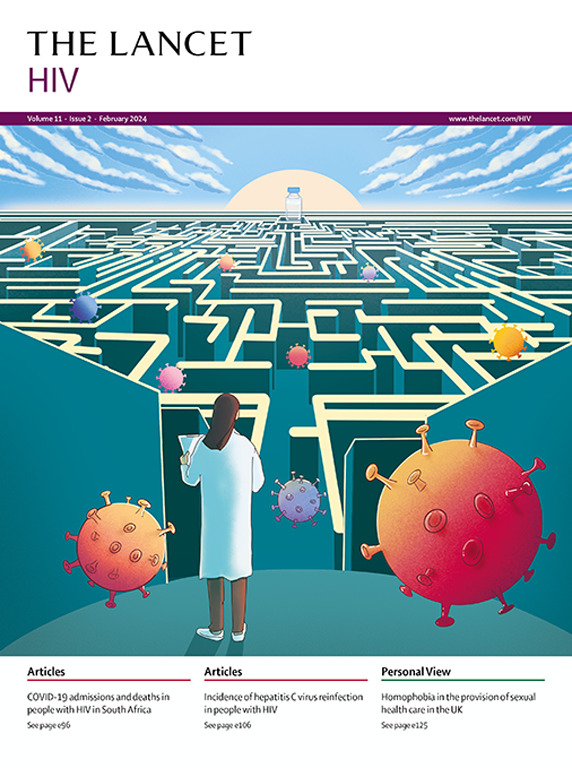eb病毒和巨细胞病毒合并感染与hiv相关隐球菌性脑膜炎患者的死亡风险:一项对AMBITION-cm随机对照试验前瞻性巢式队列的事后分析
IF 13
1区 医学
Q1 IMMUNOLOGY
引用次数: 0
摘要
背景:hiv相关的隐球菌脑膜炎病死率仍然大于25%。共同流行的感染可能导致不良结果。我们旨在了解eb病毒和巨细胞病毒合并感染在隐球菌性脑膜炎患者中的流行情况及其临床意义,以指导潜在的治疗干预措施。方法:我们使用在AMBITION-cm随机试验中收集的血浆和脑脊液(CSF)样本对前瞻性队列进行事后分析。AMBITION-cm在5个非洲国家(博茨瓦纳、马拉维、南非、乌干达和津巴布韦)的7家医院进行。试验的主要终点是10周的全因死亡率。采用定量PCR (qPCR)测定这些样本中巨细胞病毒和EBV病毒的基线载量。通过电子医疗记录系统实时捕获基线人口统计学和临床数据,包括抗逆转录病毒治疗状态,以及实验室数据,包括CD4细胞计数、CSF白细胞计数、蛋白质、葡萄糖和定量隐球菌培养。我们评估了巨细胞病毒血浆病毒血症和EBV血浆病毒血症的患病率,以及中枢神经系统合并感染,巨细胞病毒和EBV合并感染状态和基线协变量之间的相关性,以及与2周和10周死亡率的相关性。结果:在2018年1月31日至2021年2月18日期间,纳入的811名参与者中,60%为男性,中位年龄为37岁(IQR 32-43),中位基线CD4计数为27个细胞/ μL (IQR 10-58)。804名参与者中有395人(49%)出现巨细胞病毒血浆病毒血症,585人(73%)出现EBV血浆病毒血症。707名参与者中有39名(5%)在CSF中检测到巨细胞病毒,708名参与者中有191名(27%)检测到EBV。巨细胞病毒血浆病毒血症与较低的CD4细胞计数、较少的脑脊液炎症和较高的脑脊液真菌负荷相关。相反,EBV血浆病毒血症与较高的CD4细胞计数和更多的CSF炎症有关。在第2周和第10周,巨细胞病毒血浆病毒血症高水平(≥1000拷贝/ mL)患者的死亡风险是无巨细胞病毒血浆病毒血症患者的两倍(校正比值比为2.31 [95% CI 1.12 - 4.75],校正比值比为2.44[1.33 - 4.45])。EBV合并感染与死亡率增加无关。这些数据表明,巨细胞病毒可能是这种情况下的重要病原体,巨细胞病毒血症是降低成人hiv相关隐球菌性脑膜炎死亡率的潜在可改变的危险因素。现在需要并计划进行介入性试验,以确定巨细胞病毒血症的治疗是否能改善晚期HIV疾病的预后。资助:国家卫生和保健研究所、欧洲和发展中国家临床试验伙伴关系、医学研究委员会和威康信托基金。本文章由计算机程序翻译,如有差异,请以英文原文为准。
Epstein-Barr virus and cytomegalovirus co-infections and mortality risk in patients with HIV-associated cryptococcal meningitis: a post-hoc analysis of a prospective nested cohort in the AMBITION-cm randomised controlled trial.
BACKGROUND
HIV-associated cryptococcal meningitis case fatality remains greater than 25%. Co-prevalent infections might contribute to poor outcomes. We aimed to ascertain the prevalence and the clinical significance of Epstein-Barr virus (EBV) and cytomegalovirus co-infections in patients with cryptococcal meningitis to guide potential therapeutic interventions.
METHODS
We conducted a post-hoc analysis of a prospective cohort using plasma and cerebrospinal fluid (CSF) samples collected in the AMBITION-cm randomised trial. AMBITION-cm was done at seven hospital sites across five African countries (Botswana, Malawi, South Africa, Uganda, and Zimbabwe). The primary endpoint of the trial was all-cause mortality at 10 weeks. Quantitative PCR (qPCR) was used to measure baseline cytomegalovirus and EBV viral loads in these samples. Baseline demographic and clinical data including antiretroviral therapy status, and laboratory data including CD4 cell count, CSF white cell count, protein, glucose, and quantitative cryptococcal culture were captured in real time via an electronic medical records system. We assessed the prevalence of cytomegalovirus plasma viraemia and EBV plasma viraemia, and CNS co-infections, associations between cytomegalovirus and EBV co-infection status and baseline covariates, and associations with 2-week and 10-week mortality.
FINDINGS
Between Jan 31, 2018, and Feb 18, 2021, among 811 participants enrolled, 60% were male, median age was 37 years (IQR 32-43), and median baseline CD4 count was 27 cells per μL (IQR 10-58). Cytomegalovirus plasma viraemia was present in 395 (49%) of 804 participants and EBV plasma viraemia was present in 585 (73%) participants. 39 (5%) of 707 participants had detectable cytomegalovirus in the CSF and 191 (27%) of 708 participants had detectable EBV. Cytomegalovirus plasma viraemia was associated with lower CD4 cell counts, less CSF inflammation, and higher CSF fungal burdens. Conversely, EBV plasma viraemia was associated with higher CD4 cell counts and more CSF inflammation. At 2 and 10 weeks, the risk of mortality was two times higher in participants with high-level cytomegalovirus plasma viraemia (≥1000 copies per mL) than in participants without cytomegalovirus plasma viraemia (adjusted odds ratio 2·31 [95% CI 1·12-4·75] at 2 weeks; 2·44 [1·33-4·45] at 10 weeks). EBV coinfections were not associated with increased mortality.
INTERPRETATION
These data indicate that cytomegalovirus might be an important copathogen in this context, and that cytomegalovirus viraemia represents a potentially modifiable risk factor to reduce mortality among adults with HIV-associated cryptococcal meningitis. Interventional trials are now required and planned to determine whether treatment of cytomegalovirus viraemia improves outcomes in advanced HIV disease.
FUNDING
National Institute for Health and Care Research, European and Developing Countries Clinical Trials Partnership, Medical Research Council, and Wellcome Trust.
求助全文
通过发布文献求助,成功后即可免费获取论文全文。
去求助
来源期刊

Lancet Hiv
IMMUNOLOGYINFECTIOUS DISEASES&-INFECTIOUS DISEASES
CiteScore
19.90
自引率
4.30%
发文量
368
期刊介绍:
The Lancet HIV is an internationally trusted source of clinical, public health, and global health knowledge with an Impact Factor of 16.1. It is dedicated to publishing original research, evidence-based reviews, and insightful features that advocate for change in or illuminates HIV clinical practice. The journal aims to provide a holistic view of the pandemic, covering clinical, epidemiological, and operational disciplines. It publishes content on innovative treatments and the biological research behind them, novel methods of service delivery, and new approaches to confronting HIV/AIDS worldwide. The Lancet HIV publishes various types of content including articles, reviews, comments, correspondences, and viewpoints. It also publishes series that aim to shape and drive positive change in clinical practice and health policy in areas of need in HIV. The journal is indexed by several abstracting and indexing services, including Crossref, Embase, Essential Science Indicators, MEDLINE, PubMed, SCIE and Scopus.
 求助内容:
求助内容: 应助结果提醒方式:
应助结果提醒方式:


